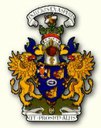Compiled from an email posted by Barbara R Dorey; sorry, original details have been lost.
The Fergusons or Fergussons, are a very ancient clan of Gaelic origin. They are believed to have descended from Fergus, a Dalriada Prince of Galloway who was married to a daughter of Henry I of England. Prince Fergus was the ruler of Galloway in 1165. They became the Lords of Galloway and Allan, Lord of Galloway witnessed King Alexander II’s charter to the monks of Melrose. Alan was the last Prince of Galloway before it was annexed by Scotland 1234.
The Fergusons developed into many branches. The Craigdarroch branch in the oldest but branches were in Cowalm, Kintyre, Kilkerran, Atholl, Kimmundy, and Pitfour. Like many other Clans of the central Highlanders their territories were scattered and all though kinship existed between the various branches it was not until the 18th century that the Clan was brought together again under one leadership.
In 1489 the Dunfallandy branch were influential over a wide stretch of the banks of the Tummel in Strathardleand Glenshee and they were in constant trouble with the Government as their lands gave shelter to bandit elements. Baron Ferguson, who ruled these lands from within an unofficial barony, had to rule with an iron hand to control the ‘broken men’ who used the glen as a haven from their misdeeds.
In 1587 the Fergusons of Atholl and Strathardle were granted charters of land by King John Balliol so it may be assumed that any differences between the Fergusons and the crown were by that time settled. The Kilkerran Fergusons were active in affairs of State and Sir. James took the title Lord Kilkerran. His son was made Lord Hermand.
The Fergusons were not generally sympathetic to the jacobite cause in the rising of 1745, and fought on the side of the government against pretender, Prince Charles. It was Capt. John Ferguson of H.M.S. Furnace who pursued the Prince throughout the Western Isles after his defeat at Culloden. When asked by a kins woman whether he would accept 30,000 pounds reward Ferguson replied, “No, by god, I would have preserved him as the apple in mine eye, for I wouldn’t take any man’s word, no, not even the Duke of Cumberland’s, for 30,000 pounds sterling, though I knew many to be such a fool as to do it.”
It was a member of the Fergusons of Raith, Col. Sir Ronald C Ferguson who commanded the Cameron Highlanders and for whom a special medal was struck and presented by King George II and was thanked by a special act of Parliament for his courageous services in Portugal.
The Fergusons were not only famous for their military leadership and acts of valour. They also made many contributions to the Arts and Sciences. Professor Adam Ferguson was known as the father of modern sociology and in his ‘Essay on the history of Civil Society’ he insisted that mankind be studied in groups as they have always subsided. One can be reasonably certain that he was referring to the Scottish Clan system and more particularly to his own Clan.
Professor Ferguson was a confrere of the world famed philosopher David Hume. Adam Ferguson was of the Perthshire branch of the Clan.
Robert Ferguson, the poet, and Sir William Ferguson, F.R.S were other examples of cultural contributions made by the Clan. ‘Annie Laurie’ heroine of the song, was the wife of Ferguson of Craigdarroch. The Fergusons were affected by the Highland Clearances as, were most of the Highland Clans.
From 1790 to 1850 they joined most of the Highlanders in their exodus caused by the introduction of sheep into the Highlands. Many lost their Clan territories and migrated to the cities, south to England and to Ireland. Those left in the Highlands were generally reduced to poverty and many earned their livelihood by collecting Kelp (seaweed) from the coastline or from other menial tasks foreign to the Highlanders. Understandably many of the migrant sailing ships that left such as the Asia, The Hector, Dove, Hercules, John Gray, Rambler, Sarah, and so on, contained many Fergusons who chose Canada and North America as a place where the customs of Scotland, the tartan and the pipes, and the heritage of their forebears could be exercised freely. They arrived on great numbers in the early nineteenth century and settled in Cape Breton, Glengarry, Pictou, North and South Carolina, Red River and Halifax.
Meanwhile in Scotland the chiefship of the Clan passed to J.K.S. Ferguson of Dunfallandy in 1900. About the time Brigadier General Ferguson commanded the Highland Brigade winning many battle honours in taking the Cape of Good Hope. In 1906 the distinguished statesman Sir James Ferguson was killed in the Jamaica earthquake. He was the 6th Baronet. The senior house of Kilkerran is now the chief and the Clan Seat is at Kilkerran Tower.


